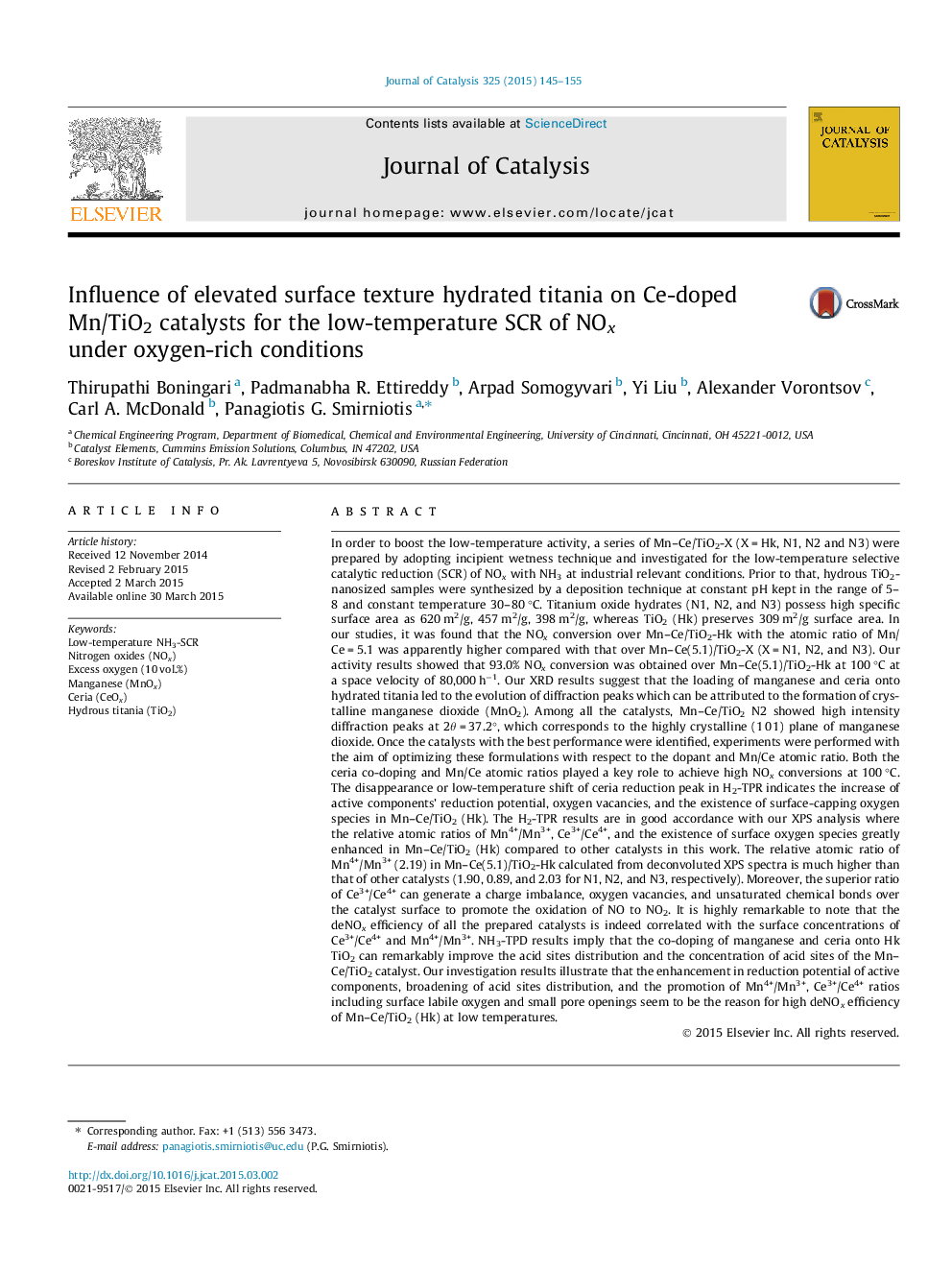| کد مقاله | کد نشریه | سال انتشار | مقاله انگلیسی | نسخه تمام متن |
|---|---|---|---|---|
| 60898 | 47551 | 2015 | 11 صفحه PDF | دانلود رایگان |

• Hydrated titania with surface area up to 620 m2/g used for SCR reaction.
• Remarkable deNOx performance at low temperatures.
• DeNOx efficiency is correlated with the surface atomic concentrations.
• Surface Ce3+ species enormously improved in Mn–Ce/TiO2 (Hk).
In order to boost the low-temperature activity, a series of Mn–Ce/TiO2-X (X = Hk, N1, N2 and N3) were prepared by adopting incipient wetness technique and investigated for the low-temperature selective catalytic reduction (SCR) of NOx with NH3 at industrial relevant conditions. Prior to that, hydrous TiO2-nanosized samples were synthesized by a deposition technique at constant pH kept in the range of 5–8 and constant temperature 30–80 °C. Titanium oxide hydrates (N1, N2, and N3) possess high specific surface area as 620 m2/g, 457 m2/g, 398 m2/g, whereas TiO2 (Hk) preserves 309 m2/g surface area. In our studies, it was found that the NOx conversion over Mn–Ce/TiO2-Hk with the atomic ratio of Mn/Ce = 5.1 was apparently higher compared with that over Mn–Ce(5.1)/TiO2-X (X = N1, N2, and N3). Our activity results showed that 93.0% NOx conversion was obtained over Mn–Ce(5.1)/TiO2-Hk at 100 °C at a space velocity of 80,000 h−1. Our XRD results suggest that the loading of manganese and ceria onto hydrated titania led to the evolution of diffraction peaks which can be attributed to the formation of crystalline manganese dioxide (MnO2). Among all the catalysts, Mn–Ce/TiO2 N2 showed high intensity diffraction peaks at 2θ = 37.2°, which corresponds to the highly crystalline (1 0 1) plane of manganese dioxide. Once the catalysts with the best performance were identified, experiments were performed with the aim of optimizing these formulations with respect to the dopant and Mn/Ce atomic ratio. Both the ceria co-doping and Mn/Ce atomic ratios played a key role to achieve high NOx conversions at 100 °C. The disappearance or low-temperature shift of ceria reduction peak in H2-TPR indicates the increase of active components’ reduction potential, oxygen vacancies, and the existence of surface-capping oxygen species in Mn–Ce/TiO2 (Hk). The H2-TPR results are in good accordance with our XPS analysis where the relative atomic ratios of Mn4+/Mn3+, Ce3+/Ce4+, and the existence of surface oxygen species greatly enhanced in Mn–Ce/TiO2 (Hk) compared to other catalysts in this work. The relative atomic ratio of Mn4+/Mn3+ (2.19) in Mn–Ce(5.1)/TiO2-Hk calculated from deconvoluted XPS spectra is much higher than that of other catalysts (1.90, 0.89, and 2.03 for N1, N2, and N3, respectively). Moreover, the superior ratio of Ce3+/Ce4+ can generate a charge imbalance, oxygen vacancies, and unsaturated chemical bonds over the catalyst surface to promote the oxidation of NO to NO2. It is highly remarkable to note that the deNOx efficiency of all the prepared catalysts is indeed correlated with the surface concentrations of Ce3+/Ce4+ and Mn4+/Mn3+. NH3-TPD results imply that the co-doping of manganese and ceria onto Hk TiO2 can remarkably improve the acid sites distribution and the concentration of acid sites of the Mn–Ce/TiO2 catalyst. Our investigation results illustrate that the enhancement in reduction potential of active components, broadening of acid sites distribution, and the promotion of Mn4+/Mn3+, Ce3+/Ce4+ ratios including surface labile oxygen and small pore openings seem to be the reason for high deNOx efficiency of Mn–Ce/TiO2 (Hk) at low temperatures.
Figure optionsDownload high-quality image (148 K)Download as PowerPoint slide
Journal: Journal of Catalysis - Volume 325, May 2015, Pages 145–155